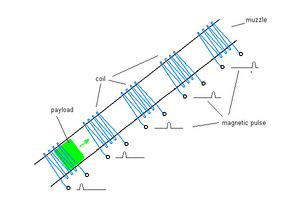Mass driver
The transport from the surface of Mars to Mars' orbit and vice versa can be achieved by a mass driver or electromagnetic catapult. The idea is to install an electrical linear motor on the surface, pointing towards the desired orbit in an appropriate angle.
A mass driver is powered electrical and requires no chemical fuels. While on Earth this would not work for lifting people to orbit, the conditions of Mars might allow it. The acceleration of persons is limited to a few g, so the linear motor must be very long for that case.
Launching a payload
The payload is accelerated along the linear motor. Until it reaches the end of the linear motor it gains enough velocity to get to the desired orbit just by inertia. The velocity must be higher than the escape velocity because of the braking effect of the Martian atmosphere.
Landing a payload
Just like launching, the landing of a payload can be done. The trajectory of the payload from outer space or from an orbit to the muzzle of the mass driver must be adjusted with nearly perfect accuracy. When entering the muzzle, the payload has a very high velocity, nearly as high as the escape velocity. The payload is decelerated by the linear motor until it comes to a halt.
Possible locations
Since the viability of a mass driver increases with a lowered atmospheric pressure, the location of the mass driver's muzzle should be as high as possible. The top (or rim) of Olympus Mons (the highest mountain in the solar system) might be a good choice with only about 40 Pa.[1][2] It also offers a natural ramp.
Open issues
- How strong is the effect of air friction at an altitude of the Olympus Mons top? Does it have a damaging effect on a steel hull?
- How much g-force can a person tolerate?
references
- ↑ Public Access to Standard Temperature-Pressure Profiles Standard Pressure Profiles measured by MGS Radio Science team at 27 km range from approx 30 to 50 pascals
- ↑ Late Martian Weather! stanford.edu temperature/pressure profiles 1998 to 2005








